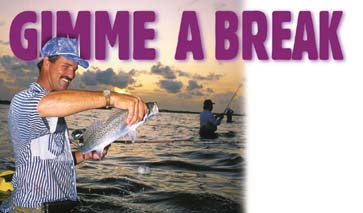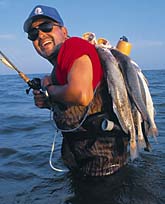|

By Buddy Gough
Page 2
Depending on location, they generally feature two
particular types of bay bottom habitat associated with shorelines
and flats. One is a bottom of sand and scattered shell. Such is
common to shorelines in the northern half of Aransas Bay and much
of Mesquite and San Antonio Bays.
The other is a mixed bottom of sand and grass beds,
which are common to the shorelines of southern Aransas Bay and
much of Corpus Christi Bay.
Over either type of bottom, the three zones are delineated
according to depth and contour. The most important of these is
the "break zone" or "drop zone."
 This is a transition zone characterized by noticeable depth change over a relatively narrow band of bay bottom. This
is where trout spend a lot of time in the spring, particularly
from mid-morning to late afternoon on mild, sunny days. The typical
depth variation is between 2-1/2 feet on the inside edge to 4
feet on the deeper edge. The depth change can be gradual over
a 20- to 30-yard swath along a shoreline or a steep and abrupt
drop of several feet along the edge of a channel. This is a transition zone characterized by noticeable depth change over a relatively narrow band of bay bottom. This
is where trout spend a lot of time in the spring, particularly
from mid-morning to late afternoon on mild, sunny days. The typical
depth variation is between 2-1/2 feet on the inside edge to 4
feet on the deeper edge. The depth change can be gradual over
a 20- to 30-yard swath along a shoreline or a steep and abrupt
drop of several feet along the edge of a channel.
The former is exemplified by the outside beach of
Traylor Island in Aransas Bay. Along this shoreline of mixed sand
and grass, the bottom slopes gently from the shore to about the
2-foot range where the slope steepens to reach 3 to 4 feet of
water over a 20- to 30-yard band.
In contrast, a steep break zone is exemplified by
Morris Cummings Cut in Redfish Bay. The channel cuts alongside
shallow flats, creating edges where depths can drop steeply from
2 to 6 feet or more.
Whether the drop zone is gentle or steep, it is bordered
by a shallow zone.
Along a shoreline, the shallow zone is the band of
water between the shore and the edge of the break. This zone is
often referred to as "tailing" or "sight-casting"
water. It is usually the first zone to target at first light on
warm spring days, especially during high tide periods. Trout can
also linger late in the shallow zone on overcast days.
On the outside edge of the break is the deep zone
where the water depth increases from approximately 4 feet to deeper
than the angler can wade. This is usually the zone of least importance
in the spring, except during unseasonably cold fronts of early
spring when dropping water temperatures drive fish into deeper
and warmer water.
However, the deep zone becomes increasingly important
to wade anglers in the heat of the summer when the depths will
be cooler and more comfortable for trout than the shallows.
Watkins' normal practice at the start of a fishing
day is to deploy his anglers knee-deep, waist-deep and chest-deep
to cover all three zones until the fishing action indicates the
most productive depth. He also watches the schools of baitfish,
which often travel a particular zone with gamefish trailing underneath.
Since light, temperature and tide conditions during
the day often affect the comfort zone for trout, Watkins may start
out wading shallow at dawn, shifting to waist-deep from mid-morning
to late afternoon and back to the shallow zone at dusk.
As Watkins expounded on the wade-fishing zones, I
recalled observing a spring gill net survey conducted in the Upper
Laguna Madre by fisheries biologists of the Texas Parks and Wildlife
Department. The biologists had strung their 600-foot nets perpendicular
to the east shore of the lagoon. The shoreward ends of the nets
were anchored at the water's edge, while the offshore ends reached
straight to water as much as 6 feet deep. The character of the
shoreline featured a shallow swath of white sand bottom - about
20 to 30 yards bordering a distinct and sharp break to grass beds
of 2 to 3 feet deep.
When the biologists checked their nets, they found
good numbers of drum and redfish and fair numbers of trout. But
there was something noticeable about the distribution of fish
in the nets.
The drum and redfish were scattered haphazard along
the entire lengths of the nets. The vast majority of the trout,
however, were within 10 yards of that break line. The remembrance
suggested there was happenstance about Watkins' wading tactics.
It's a calculated game plan suited to a fishing guide who is the
son of a high school coach.
As far as the Snowdens were concerned, they had locked
on a magical date with a magician for a guide. They suggested
getting together the same time next year.
"Yeah, we can try for a threepeat," the
sports-minded guide said.
# # # #
page 1 / page 2
| 




